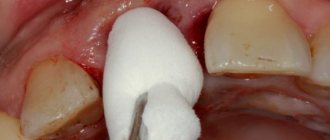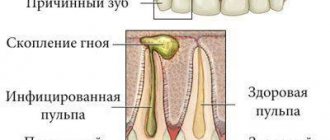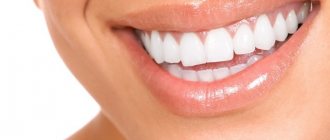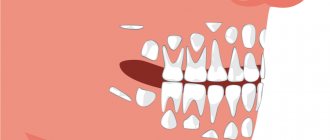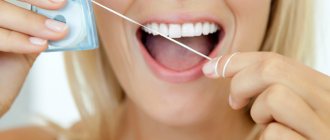If the dental crown breaks almost at the very root, there is a risk of it becoming overgrown with gum tissue. A tooth can break for various reasons - mechanical damage, trauma, for example, a strong blow, carious process, etc. Small fragments gradually come out on their own, but the root remains inside the gum. Gum tissue grows, gradually covering the rest of the tooth.
An overgrown root may not bother the patient for a long time. As the pathological process develops, painful sensations appear, the gums become inflamed and swollen. Patients often complain of pain when chewing.
An overgrown root must be removed, as overgrowth is quite dangerous and can cause serious problems:
- Dental disorder.
- Damage to adjacent teeth.
- Inflammation of the gums.
If a crown breaks off, you should consult a doctor as soon as possible. The specialist will assess the complexity of the problem and select a treatment program.
If the tooth is overgrown and the pathological process has spread to the surrounding tissues, the patient will face a rather complicated operation with a long recovery period. The wound may take a long time to heal. A timely visit to the clinic will help avoid this.
The main causes of pathology
There are a number of main reasons why a tooth can become overgrown with soft tissue. The most common reason is negligence towards periodontal tissues, refusal to visit the clinic after breaking off part of the crown. There are also quite often cases when a wisdom tooth that has not fully erupted is covered with gum on top. In the future, this figure eight can exert strong pressure on the entire dentition, which will lead to a gradual change in the bite and the appearance of serious orthodontic pathologies.
The patient may also encounter a similar situation when refusing to remove the root system of a broken tooth. As a result, a small piece of the top, as well as the root, remains under the gum, and over time they can begin to hurt and become inflamed.
It is important to note that a person’s bad habits, poor diet, consumption of junk food, chronic diseases and lack of oral hygiene can lead to teeth becoming more sensitive and brittle. As a result, the slightest pressure will be enough to cause part of the crown to break off.
Prerequisites for the development of hyperplasia
Various reasons can serve as prerequisites for accelerated and enhanced cell division:
- excessive accumulation of hard tartar and bacterial plaque above and below the gums,
- malocclusion: in such a situation, some teeth and, accordingly, the soft tissues and mucous membrane that surrounds them are subject to increased stress and pressure, they are constantly injured. The nutrition and blood circulation of tissues is disrupted, as a result of which their cells can begin to grow rapidly,
- endocrine diseases,
- genetic predisposition and heredity,
- long-term use of steroid hormonal drugs, antidepressants, anticonvulsants,
- hormonal imbalance during pregnancy, after childbirth, during menopause in women, changes in hormonal status in adolescents during puberty1,
- acute vitamin deficiency: hyperplasia often occurs due to a lack of vitamin C,
- traumatic damage to the mucous membrane due to incorrectly installed fillings, artificial crowns or braces,
- teething,
- leukemia
Consequences
If the root and part of the tooth are left inside the gum tissue, some complications may occur. Inflammation in the pulp chamber can begin as a result of dirt and infection; this process is accompanied by severe pain, the appearance of purulent discharge, rotting, etc. To avoid sepsis, surgical removal of the root and nerve endings is recommended.
Another dangerous disease is periodontitis. In the absence of timely treatment, the unit can become very loose; it is surrounded by voids where germs, food particles, and infection can get in. In this case, the root moves away from the coronal part quite quickly and it becomes almost impossible to save it. If the problem is not corrected in time, there is a high risk of damage to other organs and even blood poisoning. The latter threatens with very serious complications and is dangerous to human health.
Another common occurrence is when a previously filled tooth breaks and particles of the composite get into the hole. These particles can react with tissues, which leads to the development of inflammation. In this case, not only the root of our broken tooth can become inflamed, but also nearby units. If inflammation is left unattended by a specialist for a long period of time, a cyst may appear.
Consequences and complications if the pathology is not treated
Many patients see overgrown gums as only one problem – a significant disruption to the aesthetics of their smile. However, this is not so: if the pathology is not eliminated and it is allowed to progress further, then this is fraught with serious complications for the health of the oral cavity and the body as a whole.
If left untreated, the patient may develop degenerative diseases of periodontal tissues, leading to the destruction of the interdental septa and supporting ligaments that hold the teeth in the sockets. You may lose your teeth much earlier than you would like.
Hypertrophied tissues are subject to constant trauma, which is why any benign formation can sooner or later become malignant. Another common complication is osteoporosis.
For children, the lack of treatment is fraught with disruption of the formation, as well as the timing of the loss of milk and the eruption of permanent elements.
If a single growth appears on the gum, this may not always indicate hyperplasia or hypertrophy. Some people mistake the growth for a fistula, cyst, or abscess. If you do not consult a doctor in a timely manner for these pathologies, the purulent contents from these neoplasms can spread throughout the body, causing damage to the cardiovascular and circulatory systems, gastrointestinal diseases, sepsis and even a brain abscess.
What to do
Of course, you shouldn’t sit and wait for the pain and discomfort in the area of a tooth overgrown with gums to go away on its own. It is best to immediately contact a specialized dental clinic for medical advice. Only he will be able to conduct a comprehensive examination of the oral cavity, prescribe the necessary tests, conduct an X-ray examination and prescribe the correct treatment.
As a rule, a broken tooth that is overgrown with soft tissue is carefully removed. This requires making an incision in the gum. If the tooth is healthy, then after opening the hole the doctor can install an artificial root and prosthesis into it.
If it is not possible to save the tooth, then a procedure is performed to extract its root system. To do this, the specialist uses a special tool called an elevator, with which he cuts the top of the unit and gradually brings it to the surface. Such manipulations are carried out under local anesthesia and do not take much time. After extraction of a diseased tooth, a medicinal drug can be applied to the wound, which promotes faster healing. The stitches are removed after a few weeks.
Gum recession - symptoms and treatment
Since recession gradually progresses and can turn into a serious complication, it is necessary to undergo timely therapy in the early stages of the disease. This guarantees the effectiveness of complete cure of recession and getting rid of cosmetic defects.
The main treatment for gum recession [6] involves surgery. Thanks to the operation, the gingival contour is restored and the tooth root is closed. However, treating recession with surgery is not suitable in all cases. For example:
- surgical treatment of class I and class II recessions allows for maximum coverage of the tooth root surface;
- in the surgical treatment of class III recession, full success is observed only in some cases;
- For class IV pathology, surgical operations are not performed.
Who is indicated for the removal of dental recessions?
Carrying out such a procedure is necessary if:
- the client is not satisfied with this defect for aesthetic reasons;
- tooth enamel is highly sensitive;
- orthopedic therapy is planned;
- progression of the disease is observed.[7]
Methods of surgical treatment
Surgical treatment involves obtaining excellent results and guaranteed elimination of all symptoms of the disease. In this case, surgical intervention can be carried out using one of the following methods.[8]
Lateral flap technique . To perform the manipulation, a fragment on a stem is used, which is taken from areas adjacent to the operation site. Such plastic surgery is allowed if there is a sufficient amount of soft tissue.
At the initial stage of therapy, the doctor eliminates inflammation and eliminates deposits on the teeth. After this, a flap for transplantation occurs (as a rule, it is formed from gum tissue or hard palate). The final stage involves suturing the fabric. The use of local anesthesia is mandatory.
The relevance of this technique remains in both localized and generalized forms of the disease. Its advantage is considered to be effective restoration, since the materials are 100% identical. The only drawback of the manipulation is the feeling of slight discomfort for some time at the site of donor tissue collection. There are also cases when the flap does not take root in the transplanted area.
Resorbable membranes. This procedure belongs to the classic methods of treating gum recession and can effectively eliminate it. The manipulation is carried out in two stages:
- they begin with the installation of a membrane that has high rigidity, which avoids repeated intervention;
- after some time, the membranes are removed.
It should be noted that such operations are characterized by poor results: damaged tissues may not recover completely. Therefore, progressive doctors try not to use this technique.
Therapy with regeneration potentials of biological elements. The basis for these components are certain components that contribute to the rapid formation of renewed healthy gums. For this purpose, protein enzymes and the substance amelogenin are used. They form high-quality enamel and help restore the structure of tooth roots, and the enamel matrix allows the formation of a hard layer on damaged gum tissue.
Non-surgical treatment
A conservative method is to treat gum recession with collagen . It is recommended mainly at the initial stage of development of the disease, when slight exposure of tooth roots occurs. With the help of collagen, an excellent effect is achieved, especially if gum recession occurs due to inflammatory manifestations. When this component is introduced into the gum tissue, an aesthetic improvement of the damaged area occurs. In addition, the exposed area of the tooth is covered, which avoids undesirable effects on the general condition.[1][8]
Choosing a treatment method
Analyzing the reviews of patients and dentists about the listed therapeutic methods for treating gum recession, you can see how diverse they are.
The thing is that for some patients conservative treatment methods are perfect. However, others note that surgical intervention turned out to be effective. This means that only an experienced specialist can choose the appropriate treatment after examination and a thorough examination.
What can happen if you refuse the help of a specialist?
If the tooth root remains under the layer of gum tissue, decay can spread to neighboring units. In this case, treatment will be longer and more expensive. The main symptoms of this problem are a strong odor from the mouth and periodic pain that radiates to the head. Harmful microorganisms will begin to accumulate under the gums, which can lead to the development of caries.
In 99% of cases, the patient has a small sac with purulent filling at the apex of the root. After some time, it inevitably turns into a painful swelling called gumboil. The only correct solution when gums grow on a tooth is to quickly contact an experienced dentist. It will not only eliminate inflammation, but will also be able to save the destroyed unit.
previous post
What happens if you swallow toothpaste?
next entry
Why does the problem appear in children and when should you see a doctor?
The situation when gums grow on a child’s tooth most often occurs during the period of teething, as well as the change from a primary bite to a permanent one. During eruption, the mucous membrane swells and increases slightly in size, because it is irritated, blood circulation increases in it, but in this case we are not talking about hyperplasia. However, it is necessary to monitor the condition of the child’s oral cavity over time.
You should consult a doctor in the following situations:
- if 2-3 months after the crown “hatched”, it did not come out completely, and most of it remains under the gum or soft tissue hangs over it, partially covering it,
- the baby tooth did not fall out during the change of bite, but gums are growing on it: perhaps a permanent element is “hiding” under the formed tubercle, which did not have enough space, and it began to make its way in a different direction or into the second row,
- the growth is filled with white contents, and the child has a bad smell from the mouth: perhaps we are talking about the presence of advanced dental diseases, which are complicated by a fistula, abscess or cyst.
Plaque on teeth
It is plaque on the teeth that causes inflammation of the gums, and then the appearance of caries. If you get rid of plaque in a timely manner (at the dentist, using floss or a brush at home), then it does not have an adverse effect on your gums. But, if you don’t get rid of plaque on your teeth, it develops into tartar, which is much more difficult to remove. It is plaque “with the support” of tartar that causes inflammation of the gums. Gingivitis can also cause bleeding gums and pain when chewing food. The gums begin to swell and change color to red-violet or bright red. Inflammation can spread from the oral cavity to other organs.
Recovery period after surgery
If the gum has grown on the tooth, then now you know what to do - you need to contact a dentist who will prescribe adequate treatment.
Since treatment for hyperplasia involves surgical manipulation, there will be a recovery period after it, taking from 5-7 to 10-14 days. At this time, you need to follow all the doctor’s recommendations: take prescribed anti-inflammatory and wound-healing agents, rinse with antiseptics, and use painkillers as pain occurs.
During the rehabilitation period, it is important to exclude “irritating foods” from the diet: spicy and salty, cold and hot, solid foods. And, on the contrary, you need to diversify your diet with foods rich in vitamins C, E, B, A, calcium and phosphorus.
To care for the oral cavity, you need to use a brush with soft bristles and a non-abrasive toothpaste; you should avoid using an irrigator for a few days.
Relieving swelling with medications
Only a doctor can prescribe medications after a thorough examination of the patient and identifying the cause of the swelling: it depends on which group of drugs will be prescribed. It can be:
- antiviral agents (acyclovir, interferon, etc.). They are prescribed for gingivitis caused by viruses, accompanied by swelling of the gums and pain. In addition to tablets, the use of ointments applied directly to the gums is allowed;
- antibiotics - prescribed for bacterial nature of swelling. Among the best proven drugs are lincomycin, erythromycin and amoxicillin. Basically, antibiotics are prescribed in the form of tablets, but for greater effectiveness, the doctor in especially advanced cases may recommend injections that are more effective than the tablet form of the drug. Antibiotics disrupt the microflora, so if you have diarrhea or other disorders, you should resort to the help of probiotics (for example, Linex);
- antimicrobial ointments and gels. Metrogil denta, levomekol and other similar drugs help against swollen gums (one of the most accessible and effective remedies is Vishnevsky ointment. However, due to the strong smell, which is not pleasant for every person, it is not used so often). Most antibacterial ointments are stored in the refrigerator, therefore, in order to avoid additional injury to the gums, before use, the drug is squeezed onto a cotton swab and applied after 20-30 minutes (this is exactly the time it takes to heat the drug naturally). Medicine at room temperature penetrates the affected tissue more effectively;
- solutions that have an antibacterial effect. Rinsing is used not only for pain, but also after eating to cleanse the mouth. Miramistin, chlorhexidine (necessarily water-based), malavit, etc. are suitable for this purpose. When rinsing, the solution should be held for 20-30 seconds near the damaged area of the gums;
- painkillers. Their list is quite extensive. Among the most well-known and accessible medications are ketorol, paracetamol, analgin, solpadeine, etc. Regardless of the drugs chosen, they should be taken only after meals;
- antihistamines. Used to reduce the risk of allergies when using antibiotics. This includes suprastin, diazolin and other similar drugs.
Prevention
Preventive measures are carried out in healthy people, as well as in patients after treatment. In order to reduce the likelihood of primary periodontitis or its relapse, it is necessary to follow some rules:
- Brush your teeth daily and thoroughly with a suitable toothbrush and toothpaste.
- Use additional products (dental floss, balms, etc.).
- Periodically have your mouth professionally cleaned at your dental clinic.
- Visit the dentist at least twice a year.
- Treat caries and other dental diseases in a timely manner.
- Try not to injure your gums.
- If gums become inflamed, painful or bleeding, consult a doctor immediately.
- Include vitamins and minerals in your diet.
- Lead a healthy lifestyle, give up bad habits.
These simple recommendations will help maintain the oral cavity in proper condition and prevent the development of many dental diseases, including periodontitis.
Is it possible to get rid of the problem on my own?
Some people use decoctions of medicinal herbs and plants (chamomile, oak bark, sage and others), as well as solutions to relieve gum inflammation (such as Chlorophyllipt or Stomatophyte) to get rid of the problem. However, you need to understand that hyperplasia cannot be cured by rinsing. This measure will not reduce the volume of overgrown tissue, but will help relieve signs of the inflammatory process and alleviate the condition during teething, and is also well suited as a concomitant therapy after surgical excision of excess gum tissue, which is carried out in a dental office.
Dentures also need proper care
It must be remembered that if the dental plate moves when chewing food, then you need to glue it with a special glue. This glue resembles a paste in appearance. If you experience increased salivation while wearing dentures, it is better to suck on menthol tablets or lozenges. After eating, it is better to remove the dentures, wash them with warm water and soap, rinse and put them back in place. All changes associated with age require additional care. You need to use special antibacterial tablets that not only kill bacteria, but also eliminate unpleasant odors. You need to dissolve the tablet in a glass of water and lower the prosthesis there for about fifteen minutes. Every day you need to rinse your gums with warm water with dissolved salt (1 teaspoon per glass of water). You can massage your gums daily: clasp the gum with your thumb and middle finger and make circular movements, sideways, up and down. If possible, remove the denture to allow your gums to rest. You cannot remove the prosthesis for more than one day. The cheeks and lips will begin to lose shape. It is necessary to protect the prosthesis from heat, shock, damage to the prosthesis can injure the gums or mucous membrane of the mouth. The best way to get rid of dentures is dental implantation.
Methods of treating pathology in dentistry
The most common method of removing overgrown tissue is surgical excision using a scalpel or laser. Scientifically, this surgical operation is called gingivectomy. The procedure is performed under anesthesia.
About the indications, types and complications after gingivectomy - in the feature article on the website.
If there are few damaged tissues, then doctors may suggest their removal using cryodestruction, when under the influence of low temperatures they die off on their own over time.
If tissue proliferation is accompanied by an inflammatory process, then electrophoresis and darsonvalization may additionally be prescribed.
In addition to excision of excess tissue, treatment should be carried out aimed at eliminating the cause that provoked the development of the pathology. If the cause is a malocclusion, then the patient needs to see an orthodontist, who will prescribe devices to correct the position of the dentition. If there is a fragment of a tooth inside the overgrown gum, then it is necessary to remove it or use prosthetics, if the situation allows. In case of internal diseases of the body, the patient will be referred to specialized specialists - endocrinologist, gastroenterologist, cardiologist, etc.
Dentists are required to sanitize the oral cavity and remove hard and soft bacterial plaque.

